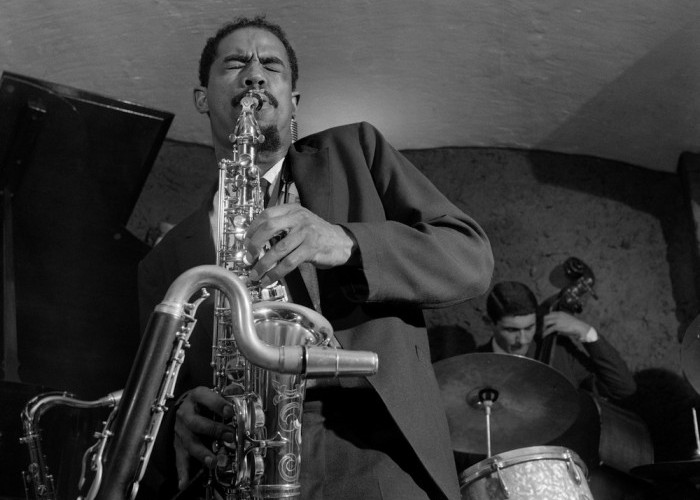Dec 9, 2025 12:28 PM
In Memoriam: Gordon Goodwin, 1954–2025
Gordon Goodwin, an award-winning saxophonist, pianist, bandleader, composer and arranger, died Dec. 8 in Los Angeles.…

Recordings that make up Musical Prophet: The Expanded 1963 New York Studio Sessions sat in a Long Island home, untouched, for decades.
(Photo: Jean-Pierre Leloir)Whether he was wielding his alto saxophone, flute or bass clarinet, Eric Dolphy was a godsend to the cadre of musicians who were on a mission to expand the language of jazz.
“He was like an angel,” Richard Davis, Dolphy’s longtime bassist, said in October. “He was my answer to wanting to play a certain way—free.” In his short life—Dolphy died in 1964 at age 36—he embraced chromatic post-bop, contemporary classical and (what later would be called) world music on their own terms. At the same time, he was moving toward a synthesis of those forms, presaging the modern global sensibility.
But he was working at a time when cultural purists often prevailed over pluralists, and, among too many critics and club owners, his expansive aesthetic marked him as an unwelcome outlier. Struggling to find work as a leader, the reedist decided that after a 1964 tour accompanying bassist Charles Mingus, he would remain in Europe. Dolphy settled in Berlin, where his diabetes went untreated, leading to his tragic death on June 29.
“When I heard it, I didn’t want to believe it,” said Davis, 88.
That sense of denial summed up the reaction of others close to Dolphy—not least his composition mentor, Hale Smith (1925–2009), and Smith’s wife, Juanita. Smith, 91, explained that the pain was so deep that, for many years, her husband refrained from digging into the boxes Dolphy had left at their Long Island home before the saxophonist departed for what would be his final tour.
“It was sort of a raw thing,” she said.
But finally, in 1978, the Smiths contacted flutist and scholar James Newton, who flew out from California to take a look. What he found was a multitude of scores and recordings, many ready to be mined. Nine years later, he produced Other Aspects (Blue Note), a 41-minute, five-track collection that, by his own account, was put together hurriedly to benefit Dolphy’s parents.
After that, Newton returned the material he had used to the Smiths’ home, where it remained until Hale’s death, when Newton became custodian of the entire cache. At that point, he undertook a more intensive exploration of the music, gradually coming to understand that it filled out the picture of a genius’ life cut short. When Resonance Records got wind of the tapes and proposed a project, Newton was game.
“I started to think that this music had to come out,” he said.
The result is Musical Prophet: The Expanded 1963 New York Studio Sessions. From seven-and-a-half hours of tapes, Newton, working with Resonance Co-President Zev Feldman at the label’s studio in Beverly Hills, culled 74 minutes of music, which had been released in the ’60s as the albums Conversations and Iron Man, plus 85 minutes of previously unreleased material. Co-produced by Newton and Feldman, the collection, which includes extensive liner notes and photos, will be available in a limited-edition three-LP version (out Nov. 23 for Record Store Day’s Black Friday event). There also will be a three-CD version and a digital edition (both out Jan. 25).
By the time Dolphy went into the studio for these sessions—on July 1 and 3, 1963—he had recorded with dozens of artists. Prominent among them was John Coltrane. Dolphy spent long hours practicing with Coltrane in the latter’s home in St. Albans, Queens, according to bassist Reggie Workman, who worked with both musicians on Impulse classics like Africa/Brass and Live! At The Village Vanguard.
“They were very close,” he said. “They respected one another highly.”
On the bandstand or in the studio, Workman recalled, the two operated as equals. No matter what Coltrane’s imagination yielded, he said, “Eric would step forward and produce something of the same nature. He always held his own. John expected you to believe in the music and know the terrain, and Eric was happy to be part of it. He always brought his own voice to the music.”

Goodwin was one of the most acclaimed, successful and influential jazz musicians of his generation.
Dec 9, 2025 12:28 PM
Gordon Goodwin, an award-winning saxophonist, pianist, bandleader, composer and arranger, died Dec. 8 in Los Angeles.…

Belá Fleck during an interview with Fredrika Whitfield on CNN.
Jan 13, 2026 2:09 PM
The fallout from the renaming of the John F. Kennedy Center for the Performing Arts to include President Donald…

Flea has returned to his first instrument — the trumpet — and assembled a dream band of jazz musicians to record a new album.
Dec 2, 2025 2:01 AM
After a nearly five-decade career as one of his generation’s defining rock bassists, Flea has returned to his first…

The success of Oregon’s first album, 1971’s Music Of Another Present Era, allowed Towner to establish a solo career.
Jan 19, 2026 5:02 PM
Ralph Towner, a guitarist and composer who blended multiple genres, including jazz — and throughout them all remained…

Dec 11, 2025 11:00 AM
DownBeat presents a complete list of the 4-, 4½- and 5-star albums from 2025 in one convenient package. It’s a great…